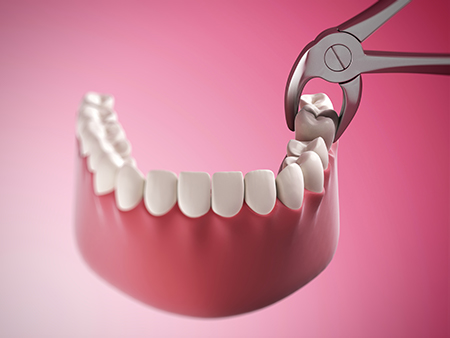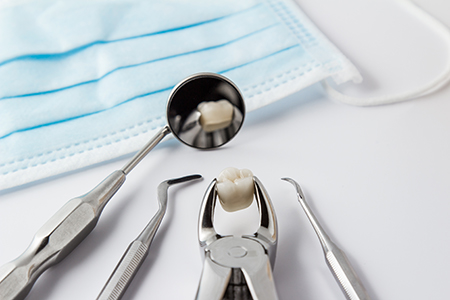
Sometimes the best way to protect a patient’s long-term oral health is to remove a tooth. Extractions are not a default or first-choice treatment; they are a measured decision used when preservation is no longer practical or safe. Our approach is to weigh the benefits and risks carefully, explain the options clearly, and prioritize comfort at every step.
Before any recommendation is made, we perform a thorough review of your dental and medical history and use diagnostic imaging to understand the full picture. That assessment helps us determine whether a tooth can be repaired, whether it should be monitored, or whether removal is truly the most responsible option for your smile and overall health.
At Smiles Dental at Reston Town Center, we aim to make the process predictable and understandable. We’ll discuss what to expect from the procedure, how recovery typically unfolds, and the replacement choices available if a missing tooth needs restoration later on. Our goal is to help you make an informed decision with confidence.
Persistently retained baby teeth
Sometimes a primary tooth fails to loosen and fall out when the permanent tooth beneath it is ready to erupt. A retained baby tooth can interfere with normal alignment and jaw development. If monitoring indicates it will block proper eruption, a timely extraction can allow the adult tooth to come in correctly.
Advanced decay that cannot be repaired
Decay that reaches deep into a tooth can destroy the structure needed for a reliable restoration. When a tooth is compromised beyond salvage—either because too much structure is lost or the root and supporting tissues are affected—removal can prevent the spread of infection and protect neighboring teeth.
Irreparable fractures or root damage
Cracks and fractures come in many forms. If a break extends below the gum line or into the root in a way that makes predictable restoration impossible, extraction can be the safest choice to avoid chronic pain or recurring infections.
Severe periodontal disease
When gum disease has destroyed the supporting bone and soft tissue around a tooth, the tooth may become loose and painful. In advanced cases where rebuilding the support is not feasible, extraction can stop further deterioration and make future restorative or prosthetic planning more successful.
Problematic wisdom teeth
Third molars frequently cause trouble when there isn’t enough space for them to erupt properly. Impacted or misaligned wisdom teeth can damage adjacent teeth, trap bacteria, or develop decay. When monitoring or treatment shows they will likely cause harm, removal is commonly advised.
Preparation for orthodontic treatment
In some orthodontic plans, selective extractions create the room necessary to align the remaining teeth and establish a stable, functional bite. When recommended, this is done in close coordination with your orthodontic provider to support the best possible long-term result.

We begin every extraction case with a focused exam and appropriate imaging to map root shape, bone levels, and surrounding anatomy. This step helps us choose the most conservative technique and anticipate whether a simple or surgical approach will be needed. We also review medications and medical conditions so we can plan safely for anesthesia and healing.
Local anesthesia is typically used to numb the tooth and surrounding tissues, and most patients report feeling pressure but not pain during the removal. For those who feel nervous about dental work, additional comfort options are available and can be discussed in advance of the procedure. Our priority is that you remain as relaxed and pain-free as possible.
After the extraction, we’ll explain immediate care instructions and schedule any necessary follow-up. If the tooth will later be replaced—by an implant, bridge, or denture—we’ll outline the timing and next steps so you have a clear plan for maintaining function and appearance after healing.
Simple extractions involve teeth that are visible and have a relatively uncomplicated root anatomy. Once the area is anesthetized, the dentist gently loosens the tooth and removes it with forceps. The procedure is efficient and usually completed in a single visit, with minimal trauma to surrounding tissues.
We focus on atraumatic techniques—careful manipulation and attention to soft tissue—to speed recovery and preserve the bone for any future restorative work. After removal, a gauze pad is placed to control bleeding and a few minutes of pressure are typically all that’s needed.
Surgical extractions are used for teeth that are broken off at the gumline, impacted, ankylosed (fused to bone), or otherwise inaccessible with standard forceps. This type of procedure may require a small incision in the gum and selective removal of a bit of bone to fully access and extract the tooth.
Complex cases may be handled in our office or referred to an oral and maxillofacial surgeon when specialized surgical skill is indicated. Regardless of location, you’ll receive a clear explanation of the procedure, anesthesia choices, and recovery expectations so there are no surprises.

Anxiety around dental procedures is common, and we offer multiple strategies to keep patients comfortable. For many extractions, local anesthetic provides complete numbness and a calm experience. If additional assistance is preferred, we can arrange conscious sedation so you remain relaxed while still responsive throughout treatment.
Options for extra comfort are discussed during your consultation so you can choose what feels right for you. We also review any medical considerations that might affect sedation choices, and coordinate with your physician when necessary to ensure safety and effectiveness.
Our team monitors you closely during and after sedated care to make sure recovery is smooth. We’ll give clear post-operative instructions tailored to the level of anesthesia used and provide guidance on pain control, activity, and wound care.
Healing after an extraction is highly individual, but most people follow a predictable course: initial clot formation and mild bleeding, followed by gradual reduction in swelling and discomfort over several days. Rest, careful oral hygiene, and adherence to post-op instructions are key to avoiding complications like dry socket or infection.
We recommend planning for light activity and easy-to-eat foods for the first 48–72 hours. Gentle icing can reduce swelling, and taking prescribed or recommended pain medication as directed helps manage discomfort so you can rest and heal more quickly. Avoid actions that can dislodge the clot, such as drinking through a straw, vigorous rinsing, or smoking.
If sutures are placed, we’ll tell you whether they are dissolvable or require removal. Your follow-up appointment, when needed, is an opportunity to confirm that healing is progressing and to begin discussing long-term replacement options if a missing tooth will affect function or aesthetics.
Control bleeding with steady pressure
Bite gently on the provided gauze until the bleeding subsides. Replace the gauze as directed, and keep pressure steady for the suggested intervals. Some light oozing can continue for a day, but heavy bleeding that doesn’t slow should be reported to our team.
Protect numb tissues
Until numbness fades, avoid chewing, and be mindful of lips and cheeks to prevent accidental bites. Use caution when eating or drinking until normal sensation returns.
Follow medication guidance
If antibiotics are prescribed, complete the course as instructed. For pain relief, take over-the-counter or prescribed medicines according to directions. Taking a recommended analgesic before the local anesthetic wears off can reduce peak discomfort.
Preserve the blood clot
Avoid spitting, using a straw, or vigorous rinsing on the first day. These actions can dislodge the clot and delay healing. When rinsing is advised, do so gently with a mild saltwater solution.
Manage swelling
Apply an ice pack to the cheek in short intervals during the first 24 hours to minimize swelling. After the first day, warm compresses may help if stiffness or soreness persists.
Avoid tobacco
Smoking interferes with clot formation and slows healing. Refrain from tobacco use for at least a week after extraction to reduce the risk of complications.
Choose gentle foods and stay hydrated
Soft, cool, or lukewarm foods are easier to tolerate in the days after extraction. Keep up fluid intake, but avoid hot, spicy, or carbonated beverages during the initial recovery period.
Maintain cautious oral hygiene
Brush carefully around the extraction area to avoid irritation. A light saltwater rinse can be introduced as directed to keep the mouth clean without disturbing the healing site.
Attend follow-up visits
Keep any scheduled appointments so we can monitor healing and remove sutures if necessary. If you notice increasing pain, persistent swelling, fever, or unusual drainage, contact our office for further evaluation.
If you experience unexpected symptoms such as prolonged heavy bleeding, increasing pain, a persistent bad taste, or signs of infection, reach out to our team promptly so we can assess the situation and provide appropriate care.

Successful extractions depend on clinical experience, careful planning, and attention to patient comfort. Our clinicians combine conservative judgment with modern techniques to remove teeth safely while preserving surrounding tissues and preparing the site for future rehabilitation when needed.
We prioritize clear communication so you understand why an extraction is advised and what alternatives were considered. If a replacement is appropriate, we’ll outline the restorative choices—such as dentures, fixed bridges, or dental implants—and help you plan the timing and steps that fit your situation.
Your safety and well-being are central to our care. From thorough medical screening to tailored anesthesia and thoughtful post-operative support, we aim to make the extraction experience as smooth and reassuring as possible.
In summary, extractions are a thoughtful, clinical response when a tooth threatens oral health or cannot be reliably restored. If you have concerns about a troublesome tooth or would like to discuss options, please contact us for more information and to arrange a consultation.

The most common reasons for tooth loss include advanced periodontal disease, extensive tooth decay, and facial trauma. According to statistics, gum disease is responsible for close to 70% of tooth loss in adults. Although less frequent than the preceding three reasons, it should also be noted that specific diseases, drugs, smoking, and poor nutrition contribute to the risk of tooth loss.
The Centers for Disease Control and Prevention report that in the United States, an average of 12 teeth (including the wisdom teeth) are lost by the age of 50. Also, 26% of adults between 65 and 74 years of age have lost all their teeth.
Every patient and every situation is different. However, when a tooth and the surrounding tissues are numbed with a local anesthetic, you should only expect to feel a bit of pressure, but no pain as the tooth is being loosened from the surrounding tissues and extracted. For patients who are apprehensive and for some surgical extractions, our office will discuss our options in dental sedation to provide further relaxation and reduce any sense of discomfort.
While it's normal to feel some tenderness and swelling following an extraction, the degree of these sensations can vary. It mostly depends on the complexity of the extraction and the body's response to the procedure. We'll recommend or prescribe the appropriate pain medication to help ensure your comfort and give you specific instructions for maximum effectiveness and safety.
Typically, the recovery period following a simple extraction is shorter than a surgical extraction. However, a patient's overall health, habits, the size and location of the tooth, and other variables can influence recovery and healing. To speed up the recovery and avoid any complications, patients must follow the given at-home instructions diligently. We'll carefully review what to expect following your procedure and go over your post-op instructions.
Smoking interferes with blood clot formation, which is an essential first step in the healing process. Blood clot formation not only provides a protective layer to cover the underlying exposed bone and nerve endings, but it also supports the growth of new tissue. Cigarette smoke also contains chemical toxins that can disrupt the healing process and lead to problems such as continued inflammation, infection, or dry socket.
In a very small percentage of cases, a condition known as dry socket can develop in the aftermath of a dental extraction. This painful condition can arise when the blood clot in the extraction site doesn't form properly or gets dislodged. With dry socket, you may experience throbbing pain and symptoms such as bad breath and an unpleasant taste in your mouth. As skilled providers of care, our office will provide immediate treatment to alleviate your discomfort and promote healing.
The last teeth in your mouth to develop, wisdom teeth often do not have enough room to fully erupt or may be positioned in the wrong direction. These issues can affect your dental health as well as overall wellbeing. While some individuals never develop all their wisdom teeth, and a few have sufficient space for them, there are many people with partially or fully impacted third molars. Our office will monitor the development, position, and health of your wisdom teeth and will advise you if and when extractions are indicated.
After a tooth is removed, bone-grafting material is sometimes placed in the socket to promote healing and encourage new bone development. This procedure is often performed to support the eventual and successful placement of a dental implant.
At the office of Smiles Dental at Reston Town Center, we strive to make dental care affordable and accessible. Depending on the type or complexity of the extraction and other variables, the cost of the procedure can vary. Based on our diagnostic findings, our office will inform you of the healthiest choices in care, explain the fees, discuss insurance coverage, and explain your payment options.
Many dental plans offer some level of coverage for tooth extractions. We'll advise you if your plan covers the full cost of the procedure and if there is any out-of-pocket expense. Our business office will work with you to maximize your insurance benefits as much as possible while helping you minimize any out-of-pocket expenses.
A dental extraction is a clinical procedure to remove a tooth from its socket in the jaw when preservation is no longer a safe or predictable option. Extractions are recommended when a tooth is severely decayed, fractured beyond repair, affected by advanced periodontal disease, or when a retained primary tooth interferes with normal eruption. The decision to extract is based on a careful assessment of oral and medical history, diagnostic imaging, and a discussion of alternatives.
Extractions are also used in specific treatment plans such as creating space for orthodontics or addressing impacted third molars that threaten adjacent teeth. The goal is to protect long-term oral health and prevent the spread of infection or further damage. Your clinician will explain why extraction is advised and outline the next steps for healing and restoration.
Determining whether to save a tooth or extract it begins with a thorough clinical exam and appropriate imaging to evaluate root shape, bone support, and the extent of disease or damage. Factors that influence the decision include the amount of remaining tooth structure, the health of the periodontal tissues, the presence of infection, and the predictability of restorative options such as crowns or root canal therapy. We also consider systemic health, medications, and patient preferences when forming a treatment plan.
A conservative approach is prioritized whenever predictable long-term success is likely, and extraction is recommended only when restoration would be unreliable or pose a risk to neighboring teeth. When extraction is necessary, the team will discuss timing, replacement choices, and steps to preserve bone and soft tissue for future rehabilitation. Clear communication ensures you understand alternatives and can make an informed choice.
A simple extraction is performed on a tooth that is visible in the mouth and has a straightforward root anatomy that can be accessed with forceps after local anesthesia. The procedure typically involves loosening the tooth and removing it with minimal trauma to surrounding tissues, followed by placement of gauze to control bleeding. Recovery from a simple extraction is usually quick and uncomplicated when post-operative instructions are followed.
Surgical extractions are used for teeth that are broken at or below the gum line, impacted, ankylosed to bone, or otherwise not accessible with standard instruments. This approach may require a small incision, careful removal of bone, and sectioning of the tooth to allow safe extraction, and it may involve sutures and a more detailed recovery plan. Complex cases may be handled in-office or referred to an oral surgeon when specialized care is indicated.
Local anesthesia is the foundation of comfort for most extractions and reliably numbs the tooth and surrounding tissues so patients feel pressure but not pain during the procedure. For patients who experience anxiety or require more extensive procedures, conscious sedation options can be arranged to keep you relaxed while remaining responsive, and these choices are discussed during your consultation. Any sedation plan is selected with attention to medical history and current medications to ensure safety.
The clinical team monitors patients closely during and after sedated care and provides clear post-operative guidance tailored to the level of anesthesia used. We review expectations for recovery, activity restrictions, and medication instructions so you leave the appointment with a safe, personalized plan. If coordination with your physician is necessary, we will make appropriate arrangements to support a safe experience.
Before your extraction appointment, provide a complete list of current medications and medical conditions so the dental team can plan anesthesia and healing considerations safely. Eat or avoid food according to the instructions provided for the chosen sedation method; for local anesthesia, normal eating is often permitted but we recommend a light meal unless otherwise directed. Arrange for a responsible adult to accompany you if you will use sedation that impairs driving or decision-making.
Wear comfortable clothing and avoid alcohol or recreational drugs before the visit, and follow any specific pre-operative instructions given by the clinician. Bring a list of questions or concerns so they can be addressed during the consultation, and expect the team at Smiles Dental at Reston Town Center to review the procedure, comfort options, and post-operative care with you prior to treatment. Clear preparation helps reduce anxiety and supports a smoother recovery.
In the first week after an extraction you can expect clot formation in the socket, mild bleeding or oozing for the first 24 hours, and gradual reduction in swelling and discomfort over several days. Rest, ice in short intervals during the first 24 hours, and following medication guidance help control pain and inflammation, while avoiding actions that dislodge the clot—such as drinking through a straw, vigorous rinsing, or smoking—is important. Gentle oral hygiene around the site and a soft-food diet for the first 48 to 72 hours support healing.
If sutures are placed, your clinician will tell you whether they are dissolvable or require removal, and a follow-up appointment may be scheduled to monitor healing. Signs of normal healing include decreasing pain, lessening swelling, and gradual return to usual function, while increasing pain, heavy bleeding, fever, or unusual drainage should prompt immediate contact with the office. Adhering to post-operative instructions reduces complications and speeds recovery.
Dry socket, or alveolar osteitis, occurs when the protective blood clot at the extraction site is dislodged or dissolves prematurely, exposing bone and causing increased pain and delayed healing. Risk factors include smoking, vigorous rinsing or spitting, use of a straw, poor oral hygiene, and certain medical conditions or medications that affect clotting. Avoiding these behaviors and following the post-operative directions provided by your clinician are key preventive steps.
If you experience severe, persistent pain a few days after extraction or notice a persistent bad taste or odor, contact the dental team promptly for evaluation. Treatment for dry socket typically involves cleaning the socket and placing a medicated dressing to promote comfort and healing, along with guidance on pain management and improved home care. Early assessment helps control symptoms and supports recovery.
Replacing a removed tooth is recommended when the missing tooth affects chewing, speech, smiling, or long-term stability of adjacent teeth and the jawbone. The timing of replacement depends on healing, the condition of surrounding bone, and the chosen restorative option; in some cases immediate or delayed placement is appropriate to preserve tissue and support a predictable outcome. Common replacement solutions include dental implants, fixed bridges, and removable dentures, each with specific advantages and clinical considerations.
Dental implants offer a durable solution that helps preserve bone and function, while bridges and dentures can restore aesthetics and chewing ability when implants are not suitable. Your dentist will discuss the pros and cons of each option based on your oral health, goals, and overall medical profile and will outline a treatment timeline so you understand next steps. Coordinated planning ensures that restorative goals are met after healing is complete.
Wisdom teeth are not always extracted; many people retain third molars without problems, but removal is commonly recommended when they are impacted, misaligned, partially erupted, or likely to cause decay or damage to adjacent teeth. Impacted wisdom teeth can trap food and bacteria, increase the risk of decay and gum inflammation, and contribute to crowding or root resorption of neighboring teeth. Regular evaluation with clinical exams and radiographs helps determine whether a conservative approach or extraction is the best course.
When removal is advised, timing may be influenced by position of the teeth, patient age, and the presence of symptoms such as pain, swelling, or recurrent infection. Early assessment and monitoring can prevent more complex problems later and allow planning for the most predictable surgical approach. Your clinician will explain the anticipated procedure, anesthesia options, and recovery expectations to help you make an informed choice.
Successful extraction care depends on clinical experience, careful treatment planning, and attention to patient comfort and safety, and our team follows evidence-based protocols to achieve predictable outcomes. We combine thorough medical screening, appropriate imaging, and conservative surgical techniques to preserve surrounding tissues and plan for any necessary restoration after healing. Clear communication about risks, alternatives, and recovery is part of our commitment to informed care.
The practice emphasizes patient safety through tailored anesthesia plans, close monitoring during sedation, and detailed post-operative instructions to minimize complications and support healing. If a case requires specialized surgical skill, we coordinate referrals to oral and maxillofacial surgeons to ensure you receive the appropriate level of care. You can rely on Smiles Dental at Reston Town Center to guide you through the process with professional, evidence-based recommendations.

Ready to schedule your next dental appointment or have questions about our services?
Contacting Smiles Dental at Reston Town Center is easy! Our friendly staff is available to assist you with scheduling appointments, answering inquiries about treatment options, and addressing any concerns you may have. Whether you prefer to give us a call, send us an email, or fill out our convenient online contact form, we're here to help. Don't wait to take the first step towards achieving the smile of your dreams – reach out to us today and discover the difference personalized dental care can make.